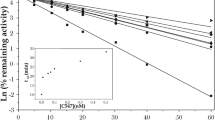Summary
Non-anesthetized, slightly atropinized dogs were given sublethal or lethal oral doses of seven commercially available organophosphate insecticide compounds. Obidoxime (Toxogonin®) was administered intravenously in doses of 5 mg/kg, which is also the dose recommended for humans. It was shown to reactivate the parathion-inhibited erythrocyte cholinesterase quickly and completely to pre-exposure levels even when administered 12 hours after the poisoning. In the case of malathion and dimethoate, less reactivation is achieved, and in fenthion poisoning the effect is only minimal. No reactivation is observed with demeton-O-methylsulfoxide or triamphos, and with mevinphos, reactivation is masked by rapid spontaneous recovery of the enzyme itself. Plasma cholinesterase, as tested with butyryl choline, was in no case reactivated. On the contrary, obidoxime leads to additional inhibition in dimethoate poisoning. The ability to achieve reactivation of phosphorylated cholinesterases by in vitro addition of obidoxime is not a suitable criterion for judging the therapeutic effectiveness of the oximes. Instead, in vivo experiments on dogs (which have an esterase spectrum quite similar to that of man) provide a usable model for evaluating the therapeutic effects of the oximes. It is necessary to separately test the erythrocyte and plasma esterases, since by the incubation of whole blood, the good reactivation activity of the erythrocyte acetyl cholinesterase may be masked by the low activity of the plasma enzyme.
Zusammenfassung
In Versuchen an nicht narkotisierten, leicht atropinisierten Hunden werden durch Zufuhr per os von 7 handelsüblichen insecticiden Alkylphosphaten subletale und letale Vergiftungen erzeugt. Die therapeutische i.v.- Gabe von 5 mg/kg Obidoximchlorid (Toxogonin), einer auch für den Menschen empfohlenen Dosis, reaktiviert die Erythrocytencholinesterase bei Parathion-vergiftung prompt und komplett, selbst noch 12 Std nach der Giftzufuhr. Nach Malathion und Dimethoate ist die erreichbare Reaktivierung geringer, nach Fenthion nur noch angedeutet. Bei Demeton-O-methyl-sulfoxid und Triamphos ist keine Reaktivierung feststellbar, bei Mevinphos wird sie durch eine rasch eintretende spontane Rückbildung überdeckt. Die Plasmacholinesterase (geprüft mit Butyrylcholin) wird in keinem Falle reaktiviert, bei Dimethoate-Vergiftung wird sie durch Obidoxim zusätzlich gehemmt. Die Reaktivierbarkeit phosphorylierter Cholinesterasen durch in vitro-Zugabe von Obidoxim ist kein geeignetes Kriterium zur Beurteilung einer therapeutischen Wirksamkeit der Oxime. Der in vivo-Versuch am Hund, einer Species, die ein dem Menschen weitgehend identisches Esterasespektrum aufweist, ist ein brauchbares Modell für Therapieversuche mit Oximen. Dabei müssen Erythrocyten- und Plasmaesterase getrennt geprüft werden, da bei Inkubation von Gesamtblut eine gute Reaktivierung der Acetylcholinesterase überdeckt werden kann.
Similar content being viewed by others
Literatur
Ammon, R.: Die fermentative Spaltung des Acetcholins. Pflügers Arch. ges. Physiol.233, 486 (1934).
Augustinsson, K. B.: Elektrophoresis studies on blood plasma esterases. I. Mammalian Plasmata, III. Conclusions. Acta chem. scand.13, 571, 1097(1959).
Durham, W. F., andW. J. Hayes: Organic phosphorus poisoning and its therapy. Arch. environm. Hlth5, 21 (1962).
Earl, W. D., R. H. S. Thompson, andG. R. Webster: Observations on the specificity of the inhibition of cholinesterase by triorthocresyl phosphate. Brit. J. Pharmacol.8, 110 (1953).
Ellin, R. I., andJ. H. Wills: Oximes antagonistic to Inhibitors of Cholinesterase. Part I and II. J. pharm. Sci.53, 995, 1143(1964).
Erdmann, W. D.: Vergleichende Untersuchungen über das Penetrationsvermögen esteraseaktivierender Oxime in das zentrale Nervensystem. Arzneimittel-Forsch.15, 135 (1965).
—: Möglichkeiten und Grenzen der Behandlung von Vergiftungen mit sogenannten Nervenkampfstoffen. Wehrmed.4, 150 (1966).
—,F. Sakai u.F. Scheler: Erfahrungen bei der spezifischen Behandlung einer E 605-Vergiftung mit Atropin und dem Esterasereaktivator PAM. Dtsch. med. Wschr.83, 1359 (1958).
—,R. Zech, P. Franke u.I. Bosse: Zur Frage der therapeutischen Wirksamkeit von Esterase-Reaktivatoren bei der Vergiftung mit Dimethoat. Arzneimittel-Forsch.16, 492 (1966).
Hobbiger, F.: Protection against the lethal effects of organophosphates by pyridine-2-aldoxime methiodide. Brit. J. Pharmacol.12, 438 (1957).
Hofmann, K. A., u.K. Höbold: Perchlorate der Cholin- und Neuringruppe: Nachweis von Cholin und Neurin. Ber. dtsch. chem. Ges.44, 1766 (1911).
Kewitz, H.: A specific antidote against lethal alkyl-phosphate intoxication. III. Repair of the chemical lesion. Arch. Biochem.66, 263 (1957).
—, andD. Nachmansohn: A specific antidote against lethal alkyl-phosphate intoxication. IV. Effects in Brain. Arch. Biochem.66, 271 (1957).
—, andI. B. Wilson: A specific antidote against lethal alkyl-phosphate intoxication. Arch. Biochem.60, 261 (1956).
— —, andD. Nachmansohn: A specific antidote against lethal alkyl-phosphate intoxication. II. Antidotal properties. Arch. Biochem.64, 456 (1956).
Namba, T.: Oxime therapy for poisoning by alkylphosphate — insecticides. Proceedings 13th Internat. Congr. Occupational Health, July, 25 (1960).
—: PAM therapy for alkylphosphate poisoning. J. Amer. med. Ass.166, 1834 (1958).Pilz, W.: Persönl. Mitt. (1967).
—, u.G. Kimmerle: Untersuchungen über esterspaltende Enzyme von Versuchstieren und Methoden zu ihrer routinemäßigen Bestimmung. II. Vergleichende Untersuchungen an fünf Esterasen im menschlichen und Rattenblut unter besonderer Berücksichtigung der Acetylcholinesterase. Hoppe-Seylers Z. physiol. Chem.329, 20 (1962).
Quinby, G. E.: Further therapeutic experience with pralidoximes in organic phosphorus poisoning. J. Amer. med. Ass.187, 202 (1964).
Sanderson, D. M., andE. F. Edson: Oxime therapy in poisoning by six organophosphorus insecticides in the rat. J. Pharm. Pharmacol.11, 721 (1959).
Wilson, I. B., andS. Ginsburg: A powerful reactivator of alkylphosphateinhibited acetylcholinesterase. Biochim. biophys. Acta (Amst.)18, 168 (1955).
Zech, R., H. Engelhard u.W. D. Erdmann: Reaktionen von Pyridiniumoximen mit dem Alkylphosphat Dimethoat und seinen Derivaten. Wirkung auf Cholinesterasen. Biochim. biophys. Acta (Amst.)128, 363 (1966).
—,W. D. Erdmann u.H. Engelhard: Grenzen der Therapie mit Oximen bei Vergiftungen mit insectiziden Alkylphosphaten. Arzneimittel-Forsch.17, 1196 (1967).
Author information
Authors and Affiliations
Additional information
Herrn Prof. Dr.Ludwig Lendle zum 70. Geburtstag gewidmet.
Rights and permissions
About this article
Cite this article
Hahn, H.L., Henschler, D. Zur Reaktivierbarkeit phosphorylierter Cholinesterasen durch Obidoximchlorid (Toxogonin) in vivo. Arch. Toxikol. 24, 147–163 (1969). https://doi.org/10.1007/BF00577821
Received:
Issue Date:
DOI: https://doi.org/10.1007/BF00577821




